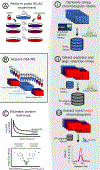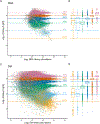Improved SILAC Quantification with Data-Independent Acquisition to Investigate Bortezomib-Induced Protein Degradation
- PMID: 33764077
- PMCID: PMC8256668
- DOI: 10.1021/acs.jproteome.0c00938
Improved SILAC Quantification with Data-Independent Acquisition to Investigate Bortezomib-Induced Protein Degradation
Abstract
Stable isotope labeling by amino acids in cell culture (SILAC) coupled to data-dependent acquisition (DDA) is a common approach to quantitative proteomics with the desirable benefit of reducing batch effects during sample processing and data acquisition. More recently, using data-independent acquisition (DIA/SWATH) to systematically measure peptides has gained popularity for its comprehensiveness, reproducibility, and accuracy of quantification. The complementary advantages of these two techniques logically suggests combining them. Here we develop a SILAC-DIA-MS workflow using free, open-source software. We empirically determine that using DIA achieves similar peptide detection numbers as DDA and that DIA improves the quantitative accuracy and precision of SILAC by an order of magnitude. Finally, we apply SILAC-DIA-MS to determine protein turnover rates of cells treated with bortezomib, an FDA-approved 26S proteasome inhibitor for multiple myeloma and mantle cell lymphoma. We observe that SILAC-DIA produces more sensitive protein turnover models. Of the proteins determined to be differentially degraded by both acquisition methods, we find known proteins that are degraded by the ubiquitin-proteasome pathway, such as HNRNPK, EIF3A, and IF4A1/EIF4A-1, and a slower turnover for CATD, a protein implicated in invasive breast cancer. With improved quantification from DIA, we anticipate that this workflow will make SILAC-based experiments like protein turnover more sensitive.
Keywords: data independent acquisition; protein degradation; protein turnover; pulse SILAC; quantitative proteomics.
Figures




Similar articles
-
Combining Data Independent Acquisition With Spike-In SILAC (DIA-SiS) Improves Proteome Coverage and Quantification.Mol Cell Proteomics. 2024 Oct;23(10):100839. doi: 10.1016/j.mcpro.2024.100839. Epub 2024 Sep 11. Mol Cell Proteomics. 2024. PMID: 39271013 Free PMC article.
-
DIA-SIFT: A Precursor and Product Ion Filter for Accurate Stable Isotope Data-Independent Acquisition Proteomics.Anal Chem. 2018 Aug 7;90(15):8722-8726. doi: 10.1021/acs.analchem.8b01618. Epub 2018 Jul 19. Anal Chem. 2018. PMID: 29989796 Free PMC article.
-
BoxCarmax: A High-Selectivity Data-Independent Acquisition Mass Spectrometry Method for the Analysis of Protein Turnover and Complex Samples.Anal Chem. 2021 Feb 16;93(6):3103-3111. doi: 10.1021/acs.analchem.0c04293. Epub 2021 Feb 3. Anal Chem. 2021. PMID: 33533601 Free PMC article.
-
Technical advances in proteomics: new developments in data-independent acquisition.F1000Res. 2016 Mar 31;5:F1000 Faculty Rev-419. doi: 10.12688/f1000research.7042.1. eCollection 2016. F1000Res. 2016. PMID: 27092249 Free PMC article. Review.
-
Quantitative proteomics using SILAC: Principles, applications, and developments.Proteomics. 2015 Sep;15(18):3175-92. doi: 10.1002/pmic.201500108. Epub 2015 Jul 14. Proteomics. 2015. PMID: 26097186 Review.
Cited by
-
Comparative Assessment of Quantification Methods for Tumor Tissue Phosphoproteomics.Anal Chem. 2022 Aug 9;94(31):10893-10906. doi: 10.1021/acs.analchem.2c01036. Epub 2022 Jul 26. Anal Chem. 2022. PMID: 35880733 Free PMC article.
-
diaPASEF Analysis for HLA-I Peptides Enables Quantification of Common Cancer Neoantigens.Mol Cell Proteomics. 2025 Apr;24(4):100938. doi: 10.1016/j.mcpro.2025.100938. Epub 2025 Mar 3. Mol Cell Proteomics. 2025. PMID: 40044040 Free PMC article.
-
In utero pulse injection of isotopic amino acids quantifies protein turnover rates during murine fetal development.Cell Rep Methods. 2024 Feb 26;4(2):100713. doi: 10.1016/j.crmeth.2024.100713. Cell Rep Methods. 2024. PMID: 38412836 Free PMC article.
-
Improved detection and consistency of RNA-interacting proteomes using DIA SILAC.Nucleic Acids Res. 2024 Feb 28;52(4):e21. doi: 10.1093/nar/gkad1249. Nucleic Acids Res. 2024. PMID: 38197237 Free PMC article.
-
Toward a hypothesis-free understanding of how phosphorylation dynamically impacts protein turnover.Proteomics. 2023 Feb;23(3-4):e2100387. doi: 10.1002/pmic.202100387. Epub 2022 Dec 7. Proteomics. 2023. PMID: 36422574 Free PMC article.
References
-
- Bantscheff M, Schirle M, Sweetman G, Rick J & Kuster B Quantitative mass spectrometry in proteomics: a critical review. Anal. Bioanal. Chem 389, 1017–1031 (2007). - PubMed
-
- Ong S-E, Kratchmarova I & Mann M Properties of 13 C-Substituted Arginine in Stable Isotope Labeling by Amino Acids in Cell Culture (SILAC). J. Proteome Res 2, 173–181 (2003). - PubMed
Publication types
MeSH terms
Substances
Grants and funding
LinkOut - more resources
Full Text Sources
Other Literature Sources
Miscellaneous

